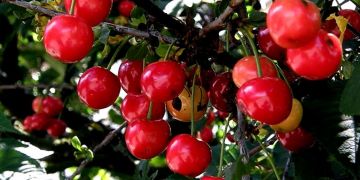Vitamin A is another important nutrient found in the acerola, yielding as much as a bundle of full-sized carrots, or approximately 3400 to 12,500 international units per 100 grams of fruit. Vitamin A plays a role in visual health, normal growth and ongoing development, red blood cell production and it protects the immune system.
Additional micronutrients found to a lesser degree in the fruit include several B-vitamins, calcium, iron, potassium and magnesium. Each of which is necessary in a normal diet. Protein, fiber and fatty acids, important macronutrients of the diet, are also in the fruit.
Acerola is also known as: Barbados cherry, West Indian cherry and Cereza. It has its origins in the Yucatan and is widely distributed throughout the hotter southern climates of the United States like Florida and Texas, as well as the Central and the northern part of South America. The plant is also cultivated throughout the Caribbean and sub-tropical regions. As of current, Brazil is the largest mass cultivar of the plant.
Acerola is a small tree or bushy shrub that grows best in tropical type climates and has poor cold tolerance because of its shallow root systems. Its leaves are a glossy lush green that varies between light and dark hues and the flowering portion of the plan blossoms five small pink to white petals. The actual fruit of the plant, which is used in the manufacture of supplements, is a bright red or yellow-orange, cherry sized lobe containing small seeds. The pulp of the fruit offers a delicately sweet aroma and taste but is acidic.
Once the fruit is harvested from the plant it must be used or converted into its supplemental form quickly because deterioration is rapid. Within three to five days the picked fruit ferments and becomes unsavory, develops mold and loses its healthful properties.
Historically, the natural form of the fruit was harvested and used to treat a host of ailments including diarrhea or inflammation of the intestines. However, it is popular as an alternative supplement to ease symptoms of the common cold, mainly because of its high vitamin C content. Supplements are also touted as energy boosters for athletic endurance, as a means for minimizing symptoms of depression and to relieve infections of the gum and tooth.
Acerola supplements are available as powder extract to be mixed into water, fruit or vegetable juices. Topical cream formulations also exist for direct skin application to enhance elasticity and collagen production or for use as an antifungal remedy. No standard dosing exists for acerola supplements as dosing is dependent upon several variables including age, current health and pre-existing conditions. Common dosing is one level teaspoon, or 3.6 grams, of powder mixed with an 8-ounce beverage and taken three to five times a week. Some manufacturers might also market acerola in oral capsule form as vitamin C. Review package labeling for proper instruction.
Clinical evidence suggests that the high antioxidant properties, which comes from the vitamins A and C, of acerola might serve as a significant element in the regular diet, as evidenced by several published research studies. Research is ongoing to determine its exact benefits and potential long term adverse effects.





